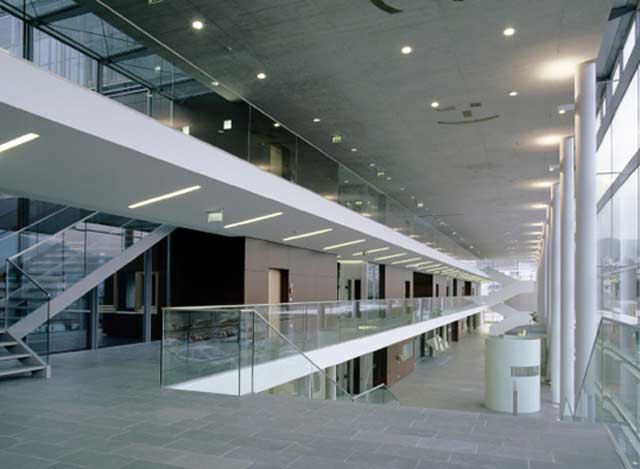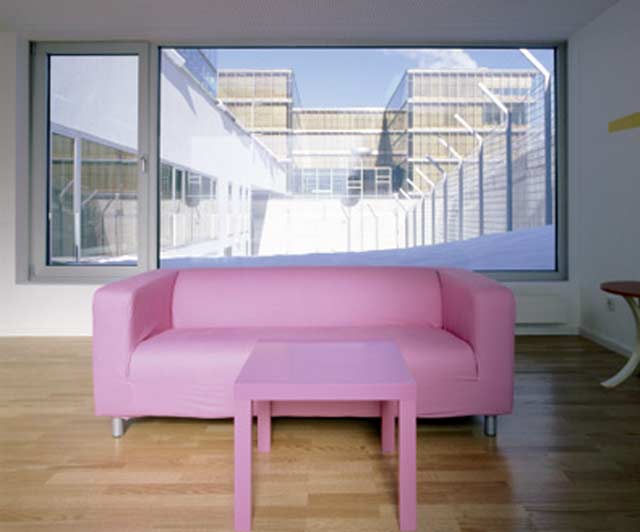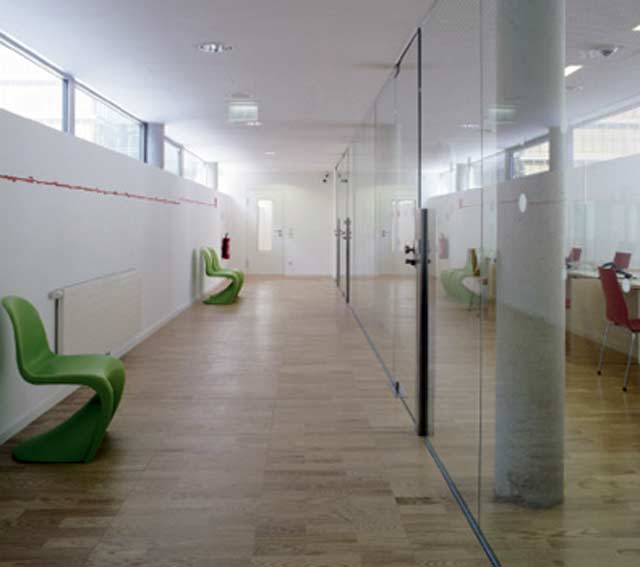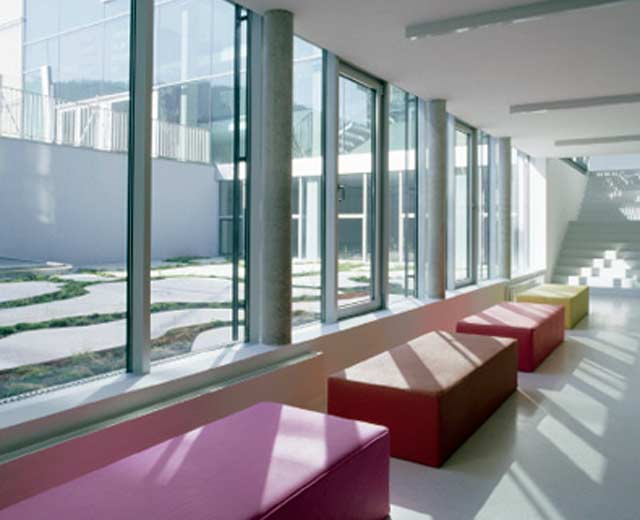Empathetic Incarceration
Justizzentrum LeobenI know what it's like to be ignored, and I think that is the big problem about the prison system: - Lee Tergesen
Source: hohensinn-architektur.at photos by Paul Ott This prison is located in Styria, Austria.l The other prisons in Austria (I presume there ARE more) may look like prisons the world over, but this one is awesome. Note: There are more photos on the following page. BackgroundThe Austrian criminal code and code of criminal procedure were riddled with Nazi amendments between 1938 and 1945 after the Anschluss (annexation by Germany), but each code was restored to its 1938 status when the country regained independence. Revisions of the criminal code in the mid-1960s, based on 10 years of work by a legal commission, give strong emphasis to the principle of government by law and allow unusual latitude in determining appropriate punishment and its implementation. Austria attempts to distinguish among lawbreakers whose crimes are committed on impulse, those who are susceptible to rehabilitation, and those who are addicted to crime and are incorrigible. Further reforms of the criminal code in 1974 emphasised the importance of avoiding jail sentences whenever possible because of the potentially antisocial effects of even a short prison term. Vagrancy, begging, and prostitution are specifically decriminalised. In large communities, prostitution is regulated by health authorities, and prostitutes and brothels are registered. Individual local jurisdictions retain the authority to prohibit prostitution, however. Provisions in the 1974 law modified the punishment for business theft and shoplifting and restricted the definitions of riotous assembly and insurrection. Incidence of CrimeThe crime rate in Austria is low compared to other industrialised countries. An analysis was done using Interpol data for Austria. For purpose of comparison, data were drawn for the 7 offenses used to compute the United States FBI's index of crime. Austria is compared with Japan (country with a low crime rate) and USA (country with a high crime rate). Index offenses include murder, forcible rape, robbery, aggravated assault, burglary, larceny, and motor vehicle theft. In the UN reports, murders are referred to as "intentional homicides." Aggravated assaults are referred to as "major assaults," and larcenies are referred to as "thefts." Data are Interpol data on crime for 2001 (for exception, see notes below).
Notes: Data for Japan for major assaults includes total recorded assaults, since Japan did not report major assaults separately. The NZ set of figures were drawn from the United Nations Seventh Annual Survey on Crime in 2000 - surveys are done every 5 years. Number of prisoners per 100,000 figures from Roy Walmsley / International Centre for Prison Studies / King’s College London – School of Law / 3rd Floor / 26-29 Drury Lane / London WC2B 5RL / International Centre for Prison Studies / October 2006 Japanese Riot PoliceExtensive experience in quelling violent disorders led to the development of special uniforms and equipment for the riot police units. Riot dress consists of a field-type jacket, which covered several pieces of body armour and includes a corselet hung from the waist, an aluminium plate down the backbone, and shoulder pads. Armoured gauntlets cover the hands and forearms. Helmets have faceplates and flared padded skirts down the back to protect the neck. In case of violence, the front ranks carry 1.2-metre shields to protect against staves and rocks and hold nets on high poles to catch flying objects. Specially designed equipment includes water cannons, armoured vans, and mobile tunnels for protected entry into seized buildings. Because riot police duties require special group action, units are maintained in virtually self-sufficient compounds and trained to work as a coordinated force. The overwhelming majority of officers are bachelors who live in dormitories within riot police compounds. Training is constant and focuses on physical conditioning, mock battles, and tactical problems. A military atmosphere prevails - dress codes, behaviour standards, and rank differentiations are more strictly adhered to than in the regular police. Esprit de corps is inculcated with regular ceremonies and institutionalization of rituals such as applauding personnel dispatched to or returning from assignments and formally welcoming senior officers to the mess hall at all meals. Trends in CrimeBetween 1995 and 2001, according to Interpol data, the rate of murder decreased from 2.19 to 1.96 per 100,000 population, a decrease of 10.5%. The rate for rape increased from 6.40 to 7.12, an increase of 11.2%. The rate of robbery increased from 50.72 to 85.84, an increase of 69.2%. The rate for aggravated assault decreased from 2.60 to 2.59, a decrease of 0.4%. The rate for burglary decreased from 1067.47 to 1035.60, a decrease of 3%. The rate of larceny increased from 1494.37 to 1944.50, an increase of 30.1%. The rate of motor vehicle theft increased from 27.70 to 48.71, an increase of 75.8%. The rate of total index offenses increased from 2651.45 to 3126.32, an increase of 17.9%. ... [Prison] regulations stipulate that all able-bodied prisoners will be put to useful work. If proceeds from an individual's work exceed the cost to the state of his maintenance, the prisoner is paid a wage. Part can be used for pocket money, and the remainder is paid to the offender after release. Where facilities are inadequate or the situation justifies work or education beyond what is available on the prison grounds, those not considered dangerous or likely to attempt to escape can work or attend classes in the nearby area. Source: www-rohan.sdsu.edu from Crime and Society: A Comparative Criminology Tour of the World by Dr Robert Winslow (rwinslow@mail.sdsu.edu) San Diego State University / his Internet research assisted by Terry Wesley and Rita Zois
For articles on white collar and petty crimes, injustice, capital punishment, race, executioners, freedom of the press, cheating, private prisons, punishment, retribution, prison
labour, appeals, instant justice, electronic tags, lepers and second chances click the "Up" button below to take you to the Table of Contents for this Prisons section. |
 Animals
Animals Animation
Animation Art of Playing Cards
Art of Playing Cards Drugs
Drugs Education
Education Environment
Environment Flying
Flying History
History Humour
Humour Immigration
Immigration Info/Tech
Info/Tech Intellectual/Entertaining
Intellectual/Entertaining Lifestyles
Lifestyles Men
Men Money/Politics/Law
Money/Politics/Law New Jersey
New Jersey Odds and Oddities
Odds and Oddities Older & Under
Older & Under Photography
Photography Prisons
Prisons Relationships
Relationships Science
Science Social/Cultural
Social/Cultural Terrorism
Terrorism Wellington
Wellington Working
Working Zero Return Investment
Zero Return Investment



